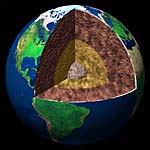| . |  |
. |
|
by Jeff Hecht  Washington - December 1, 1999 - The wobble of the Earth's spinning core and the gravitational pull of the Sun and Moon may have combined to trigger massive volcanic eruptions in the past, say geophysicists in France.
Washington - December 1, 1999 - The wobble of the Earth's spinning core and the gravitational pull of the Sun and Moon may have combined to trigger massive volcanic eruptions in the past, say geophysicists in France.The Earth's fluid core rotates at a slightly different rate to the mantle that surrounds it, and both also wobble with slightly different periods as they spin. Seismic data of the Earth has led to a model of the interior that partitions it into a core, mantle, and crust. The crust is approximately 30 kilometers thick. The mantle is approximately 2,840 kilometers thick, and the core radius is approximately 3,500 kilometers thick. Each partition can be further divided into smaller regions. The crust can be classified as oceanic or continental, the mantle as upper and lower, and the core as outer liquid and inner solid. Pictured in this cutaway view of the Earth is the crust, mantle, liquid outer core, and solid inner core. This image is Copyright � 1998 by Calvin J. Hamilton Lunar and solar tides can enhance the wobble of the core when their periods coincide with its period, hitting a resonance that increases the relative motion between the core and the mantle. But as the Earth's rotation is gradually slowing down, and the Moon is gradually orbiting further from the Earth, these factors change over time. Working backwards, Marianne Greff-Lefftz of the Institute of Global Physics in Paris and Hilaire Legros of the University of Strasbourg calculated that these effects would have peaked 3 billion, 1.8 billion and 300 million years ago. The resonant episodes would have lasted a million years and increased the friction at the base of the mantle around 10 000-fold, according to Greff-Lefftz. She suggests that this frictional heating could have sent massive plumes of hot rock from the deep mantle towards the surface. Intriguingly, the first two resonances coincide with times when the largest volumes of crustal rocks were forming. The most recent is close to the largest known eruption of flood basalts in Siberia 250 million years ago. The idea is very provocative and stimulating, says geophysicist Mi Feng of the Massachusetts Institute of Technology. But he points out that Greff-Lefftz's model ignores the larger forces that the Earth's gravity, pressure and magnetism generate at the core. Source: Science (vol 286, p 1707) This article will appear in the December 4 issue of New Scientist New Scientist. Copyright 1999 - All rights reserved. The material on this page is provided by New Scientist and may not be published, broadcast, rewritten or redistributed without written authorization from New Scientist.
TERRADAILY.COM
|
| |||||||||
| The content herein, unless otherwise known to be public domain, are Copyright 1995-2016 - Space Media Network. All websites are published in Australia and are solely subject to Australian law and governed by Fair Use principals for news reporting and research purposes. AFP, UPI and IANS news wire stories are copyright Agence France-Presse, United Press International and Indo-Asia News Service. ESA news reports are copyright European Space Agency. All NASA sourced material is public domain. Additional copyrights may apply in whole or part to other bona fide parties. Advertising does not imply endorsement, agreement or approval of any opinions, statements or information provided by Space Media Network on any Web page published or hosted by Space Media Network. Privacy Statement All images and articles appearing on Space Media Network have been edited or digitally altered in some way. Any requests to remove copyright material will be acted upon in a timely and appropriate manner. Any attempt to extort money from Space Media Network will be ignored and reported to Australian Law Enforcement Agencies as a potential case of financial fraud involving the use of a telephonic carriage device or postal service. |